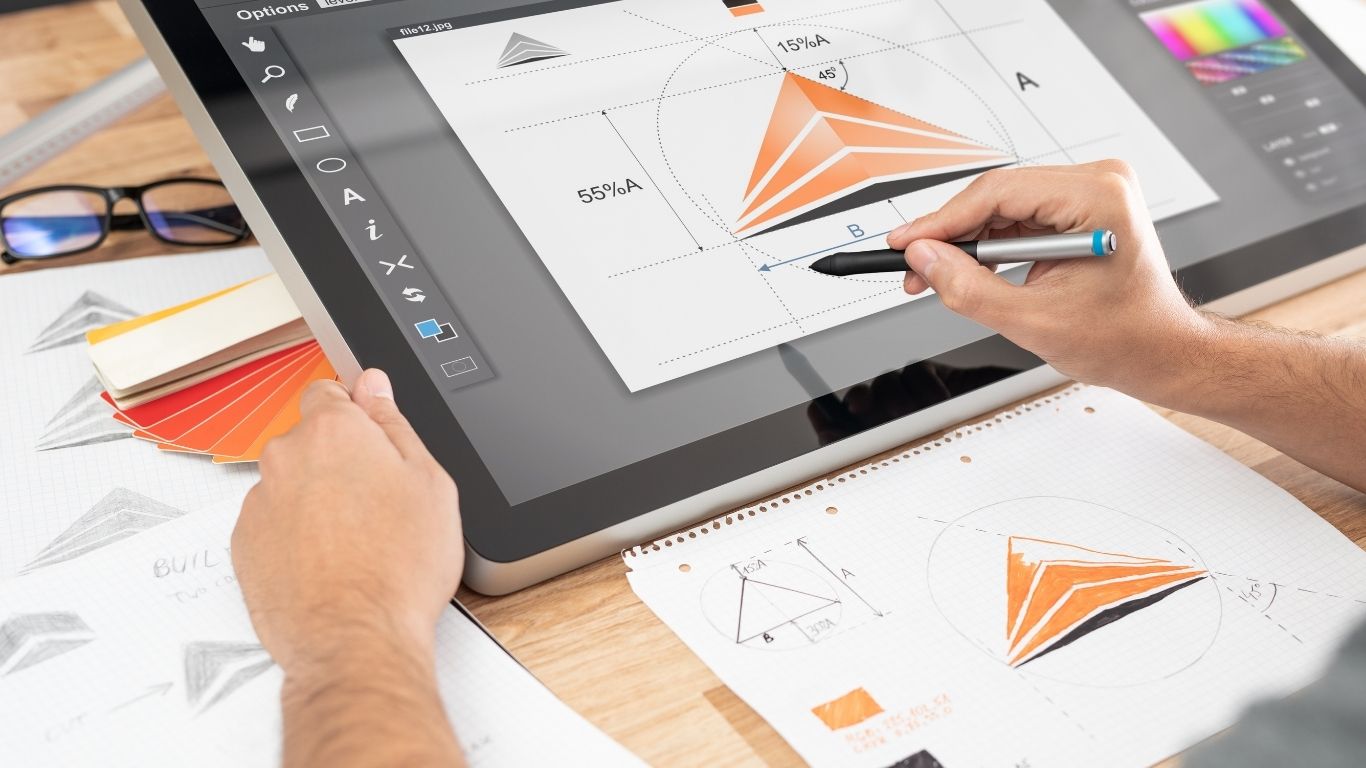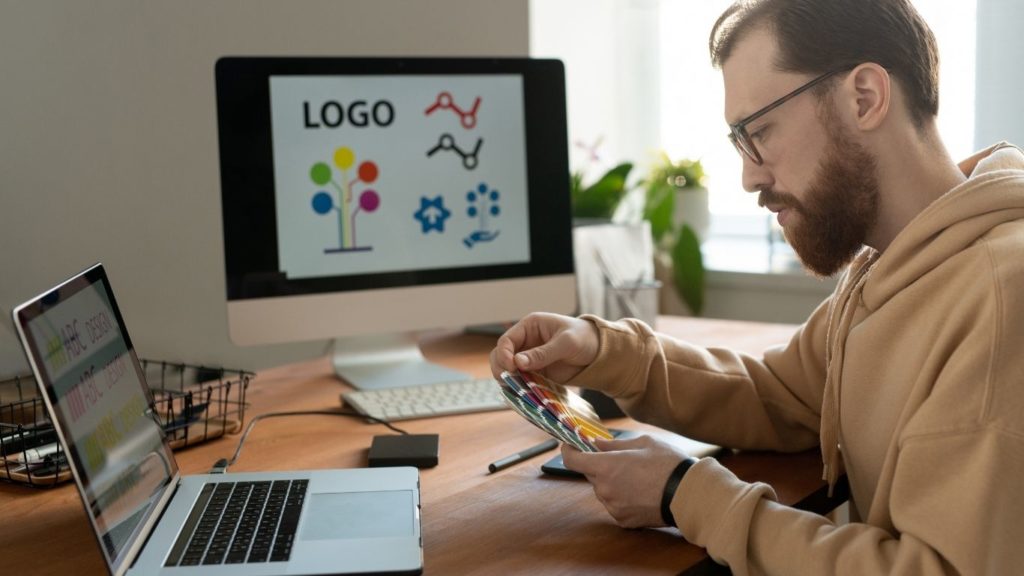

Quick Links
Quick Links
Knowing how to design a logo is one of the most important skills you need as a graphic designer. Chances are, you’ll find clients who’ll need you to create a logo from scratch or to completely revamp the one they currently have.
Regardless of the kind of project, you’ll get, the logo design process largely remains the same. Today, we’re talking about what goes into creating a logo—from concept development to execution so you can design a logo that your clients will love. Let’s get started.
Why Logos Are Important

Logos are graphic marks, emblems, or symbols used to promote the public identity of a brand, organization, or even person as well as everything that is associated with it including its products and services. It can be abstract or figurative. It can also include the text of the name it represents.
It is one of the ways that a brand is recognized and remembered among a sea of competitors. It can also serve as the face of a business. Furthermore, it can also be used to make a statement about an organization in a creative and visual way.
Logos are important for a number of reasons including:
Logos Grab Consumers’ Attention
A well-designed logo is one of the quickest ways to grab people’s attention and communicate what a company stands for in an interesting way.
Logos Help Make a Strong First Impression
A logo can be a company’s first touchpoint with its consumers. If it is made well, it can reel potential customers in and invite them to learn more about the brand.
Logos are An Integral Part of a Company’s Brand Identity
A logo is an integral part of your client’s brand identity. It is a part of a broader visual identity including tangible things like colors, typography, visuals, and layout as well as intangible aspects like their values, tone of voice customer service philosophy, business processes, marketing approach, and more.
Logos Make a Company Memorable
A strong logo gives people a visual anchor to a company or organization. It connects symbols to what a company does and what customers feel about it.
Logos Can Help a Company Stand Out
A good logo does convey everything about a company including its background, mission, and values. These are the things that show customers what separates your client from the competition.
Logos Promotes Brand Loyalty
The familiarity that a logo creates fosters brand loyalty. Consumers are more likely to seek out a company that they like again and again and the first thing they’ll look for is its logo.
How To Design A Logo That Your Clients Will Love

Designing a great logo requires a lot of strategizing. It’s more than just drawing symbols and inserting some text. As a designer, you need to think about how individual design pieces will work together and will fit into a larger visual system for your client. You also need to understand
If you’re wondering how to design a logo for your clients, then these ten tips might just be what you need:
Understand Your Client’s Company Story
Before anything else, it’s important to get as much background information and context as possible to fully understand your client’s company or organization. Use this time to determine key pieces of information like:
- the reason for their need for a new logo
- the story behind their company name
- what their company does and why
- their target audience and main competitors
- their goals for the logo
- the values they wish to express in the logo
- their unique characteristics as a brand
- the places where the logo will be used ( on merchandise, social media, website, on their brick and mortar store)
- any special attributes they want to incorporate into the design
Determine the Type of Logo You’ll be Designing
Logos come in different types and depending on the needs of your client you’re likely to client one of these:
Monogram or Lettermark
These are usually the initials of the company you’re designing for. Think ‘HBO’, ‘IBM’. Even ‘NASA’. Brands or organizations with lengthy names often use this type of logo. This typography-based logo relies on simplicity and legibility. For new brands, it’s best to include the full name of the business below the logo to help consumers get familiar with the brand.
Wordmarks or Logotypes
This is another typography-based logo that focuses on the name of the company or organization. It is best used for clients with a distinct name. Using the right font that best captures the essence of what your client does is important
Logo Symbols or Pictorial Marks
This is a graphics-based logo much like the Apple logo or the Twitter bird. Picking the right image and stylizing it the right way is crucial.
Abstract Logo Marks
Similar to logo symbols, these are graphic-based. What sets it apart, however, is the use of abstract geometric forms. Think of the Pepsi logo or the Nike swoosh. This is a great way to symbolically convey what a company does while using form and color to convey meaning and attribute emotion around a brand.
Mascots
These are illustrated characters like KFC’s Colonel Sanders or the Cheetos tiger. These cartoonish characters serve as a brand’s spokesperson.
Combination Marks
This is a logo uses the typography-based logo and a graphic-based logo that is staked side by side or on top of each other to create a single image. Think of the Lacoste logo or the Burger King logo.
Emblem Logos
Usually seen as badges, seals, and crests, this type of logo consists of font inside a symbol or an icon. This is usually used by schools and universities, organizations, and government agencies. But you can also see modern iterations of this on the Starbucks and the Harley-Davidson logo.
List Words that Describe the Brand
Write down 6 to 10 words that describe the brand you’re designing for. Identify attributes that best represent them including their values, the benefits the business is most known for, the specific features of their products, and more.
Are they innovative? Are their products easy to use? Are they friendly? Are they known for being hip?
You can even use online tools to find similar terms that can paint a verbal picture of the brand. These words can help you in putting together imagery and can guide the design choices you’ll make later on for the logo.
Start Sketching Out Ideas
Using the keywords you’ve come up with in the previous step, start sketching out your ideas. Explore different styles and directions but don’t get lost in the details. Remember, you can fill out details later. Right now, you’re just exploring big forms and shapes for your logo design.
Be Smart About Negative Space
Using blank space effectively can make for a clean and versatile logo design. You don’t always need a whole slew of visual elements to make your design pop. Sometimes less is more. Also, having enough white space can make it easier to incorporate a logo into different marketing collateral seamlessly.
Choose the Tip 3 Concept Sketches
Once you have a bunch of different concepts on paper (or your chosen sketching tool), it’s time to pick the ones that catch your eye.
Pick three of your best concepts and how it to people who fit your client’s buyer persona to see how they would react. Alternatively, you can show your best 3 concept sketches to your client so they can choose which one they think best suits their needs.
Refine Your Sketch
Once you have a sketch that your client’s customers can identify with, it’s time to refine your sketch and turn it into a usable digital image. Develop your sketch further and get the layout right.
Develop Color Variations for the Logo
Logos will be used in a wide variety of contexts from merchandise like t-shirts, mugs, and notepads to signboards, websites, and social media posts. So it’s important to pick color variations that look great on any background.
You might have to change the color of the text in your logo or you may also need to change the entire color scheme.
Furthermore, a logo should also look good in black and white. Even without the colors associated with the brand you’re designing for, the logo should still stand out.
Use the Right Font
A logo’s text matters just as much as its imagery. And when you’re making a wordmark or a letter mark logo, your choice of typeface takes center stage. Make sure that the font you use goes well with the branding of your client. Make sure also that it is legible no matter where it is placed or used.
Avoid generic fonts that you can see in every word processor as these will only make your logo unmemorable. There are thousands of fonts options available online. You can even try making your own if your client requires it.
Make Sure that Your Logo is Scalable
Logos are meant to be used on multiple platforms—from the smallest of items like pens and notepads to social media business pages to billboards, and store signs. So your final product should be a vectorized image that looks good no matter the size it will come in.
Conclusion
Knowing how to design a logo takes a clear understanding of the brand you’re creating it for. As a graphic designer, you should be able to come up with a design that is unique, effective at communicating a brand’s message, and is versatile enough to be used in any setting.
Interested in learning more ways to give your clients the best experience? Check out our blog post to learn what graphic design skills will help you land high-paying clients.
